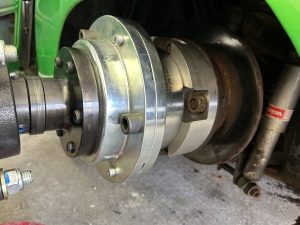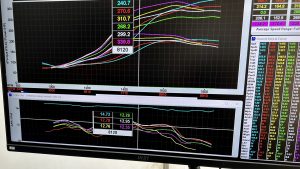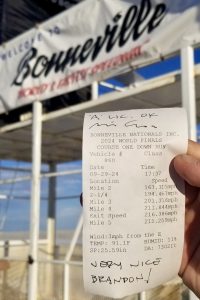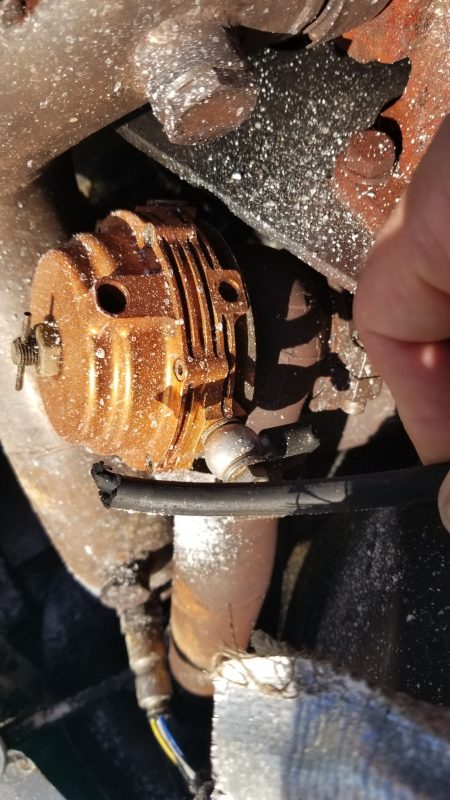If you need a refresher, see: An Abbreviated Pickle History
In late 2023, we said, “Let’s be ready for Speedweek ’24”
- Improvements: We abandoned the fancy split-collar axle sprocket mounts and cut a keyway in the solid front axle instead, changed from a set of independent GoPros to a simpler 4-camera setup, made the steering wheel removable, and did some tiny tuning to avoid loading up during our long warm-up idling
- Maintenance: Pickle got some body ‘freshening’ and paint, a new ECU Battery, an automatic thermo-switch, and some new brake lines
- Safety: belts, helmets, fire extinguishers, clothing… all items are up-to-date and certified
- Schedule: Our list was down to the ‘nice to haves’ by four weeks out — probably a record for our deadline performance
This Is The (Speed)Week That Was
It was so very, very, very hot. 110+ hot. Other teams’ engines–that had never been troublesome before–were melting during their runs. We were melting ourselves; the staging lines were desert-caravan long. A partial cause of the long lines was that recent years had seen bad salt conditions, so this year brought out all the pent-up racers.
Sat Aug 3 – At 3:10pm, there were still 55 vehicles in line for the short course. We did not join the queue that day, and instead went looking for lodging. Wendover was FULL. Found a hotel in Wells, and made the 60 mile transit that night and the following morning.
Sun Aug 4 – Final prep, got in line. The short course was cursed with Instagram influencers, 50mph mopeds, rookies, and folks whose cars and/or drivers weren’t yet qualified for the long course. It moved at the speed of a glacier. We waited about 5 hours, didn’t reach the starting line, and parked on the side of the lane in a queue for the following morning.
Mon Aug 5 – Next morning, after the Record Runs, we got our first run at 8:58am. Only three miles on the short course, and we ran 178mph in Mile 3, but missed the 175mph “in the quarter” which could have promoted us the to the long course. Questions about the car’s performance and checking the chain took the rest of the day. We planned to get in line early for Tuesday.
Tue Aug 6 – Made a run at 12:24pm, and qualified for a record (back-up) run with a 192mph in Mile 3. Okay! That’d be more than 12mph over the record if we could back it up. We took the record-run-same-day-at-4pm option – but when we reached the head of the line, the car would not start. We pushed it off, and the Hayabusa roared … for a second or two, then Pickle coasted off the course before the first quarter-mile marker.
Back in the pits, we started diagnosis, but turned up nothing conclusive. Review of data later that evening showed a curious trace on the VBAT value, which suggested that the Pectel was powered-on continuously — but the injectors and coils were not.
Wed Aug 7 – We hit the salt early to correct the non-starting. We found a broken wire, probably caused the previous afternoon in impound, as we were draining the intercooler. The long (nightmare-long) waits in the staging lanes, made more hellish by the heat, convinced us to switch drivers and we moved to the long course.
The long course is run by both fast cars (less time on course) and by experienced teams (less time spent at the starting line). It moved more quickly than the short course line, and we made a run at 13:26pm. Over 190mph in both Mile 3 & Mile 4, hellya; but later we were disqualified and kicked out of Impound for a procedural error during the run.
In the pits, we found a split CV boot and … we were hearing some CV Joint noises. It’s probably worth saying that the drive chain, so far, was looking very good after every run.
Thu Aug 8 – Some shrinkage of the staging lines. On the long course, we made a run at 10:03am, and again qualified for a back-up (record) run by going over 194mph in Mile 3 and Mile 4.
We took the record-run-the-same-day-at-4pm option, and pushed off the starting line at 16:47pm. But Pickle broke the chain almost immediately off the line, and again we failed to “back up the qualifier”.
In the pits, we found a tooth broken off the primary sprocket. That’s new; the primary sprocket is hardened steel, and has never caused a problem before. But our best guess is that the loose tooth got lodged in the next sprocket valley and that popped the chain. We had no spare primary sprocket, and we had a bit of damage to the clutch pushrod, so our week was finished.
Our score for the week was 3/6: three times in Impound, but three failures to complete the backup run. 🙁
We were encouraged that we had multiple runs over 190mph, but still troubled by the chain, CV joints, and the boost control system. We found the boost knob at 26 clicks out from minimum, while our spec said it should be 10 clicks out: how…?. Our MAP sensor recordings showed good peaks in the lower gears, but when Pickle settled in for a long pull, the graph came down then looked like it was ‘fluttering’ in a narrow range. We surmised the fluttering was the action of the wastegate… but why the boost control system allows larger peaks earlier is a head-scratcher.
Pickle went into the trailer and we drove home.
Just In Case We’re Going To World Finals
Though our SpeedWeek performance was not satisfying, the Salt was pretty good. We started watching the weather for the late September/early October meet “World Finals”. What must we do to improve our chances in the few weeks we have?
- We intensively reviewed our chains and sprockets; laid on plenty of spares, and there was talk of changing them every two runs?
- Through the SecretSAAbSociety, we got a stack of new-to-us CV joints, and assembled both axles with good joints, new boots, and new grease
- We disassembled the wastegate and manual boost controller, looking for answers on the inconsistent boost. As far as we could tell… all was well? But the boost controller confused us.
- In the garage, using an elegant ExtremeTurboSystems tool, we found and fixed a host of boost leaks, including a MAP sensor that had cracked its cover and failed.
- In a remarkable flurry of speed-fabrication, we built “hub adapters” for the ’59 SAAB to connect it to a modern dyno at English Racing.

- The dyno showed that a prime cause of boost unpredictability was our “bleed type” manual boost controller. It also showed that the Hayabusa motor could still produce serious power. We fitted a dead-simple manual boost controller and dialed in a ‘safe’ level
- Lucas (the tuner on-site at the dyno) opined that our on-power fueling might be way too rich, and costing some power… but we deferred further tuning for a future day.

World Finals ’24
Surprising even ourselves, we were ready again, with no known issues. We expected to make a couple of 190mph runs right off the bat.
Sat Sep 28 – We got through a moderate staging line, in moderate temperatures, and made a run at 5pm. Top speed was barely over 180mph. We qualified for a record attempt, but what happened to the 195 mph runs we’d begun to think were normal?
In Impound, our drive chain looked like raw bread dough… after the single run. We spent most of our allotted time in Impound replacing that chain.
We got no logging out of the Pectel ECU on that run (probably from our error during a previous “let’s write new log settings” session), but the databox had its own MAP, and that MAP sensor said the maximum boost was lower than we wanted–so we gave the manual boost controller 2 1/2 turns toward the positive.
We left Pickle in Impound overnight.
Sun Sep 29 – What do you know? The Pickle (which is the current and previous record holder in Blown Gas Coupe BGC) was disqualified and got kicked out of Impound.
The rule cited was “the radiator cannot be blocked before or behind”… and that rule, ill-suited as it is to a car whose factory radiator location is behind the engine, was now held to bar any record attempts on the Blown Gas Coupe record. If you’re wondering, the Pickle has had the exact same radiator configuration during each of its Bonneville meets since at least 2014.
Luckily, we were ready to change classes. We’d brought the body parts (including the crowd-pleasing aluminum stabilizers at the rear) required to make the Pickle into a Blown Gas Altered Coupe. Installing those parts took some time, then the car had to go through Tech Inspection again, and get the gas tank full and sealed, and get in the single staging line…
We reached the head of the staging line after 5pm. The course was overdue to close, but the SCTA stalwarts were still starting cars. We had to make a decision: if we ran that night, we’d have only an abbreviated time in Impound (assuming we qualified and went to Impound). Normally in Impound we’d be able to work on the car for 4 hours, but the Impound area itself was set to close at 7pm. But–as the whole meet is short–we thought “Let’s run if we can”.
So we pushed-off at 17:37, and Brandon took the Pickle faster than she’d ever run before.
Holey moley fast. Our speeds in two measured miles were well over the existing record. This gave us some ‘breathing room’ for our second run. If we couldn’t quite reproduce those high speeds the next day, even a speed around 198mph would make the two-run average safely over the 203.5mph number we needed.
In our precious time in Impound, we downloaded data and started on the checklist. First Item: inspect chain. The drive chain was little loose, but only a little; and it was the chain type that we used for multiple runs at SpeedWeek; and besides: we had no time to change it. Guess that item’s complete…
Reviewing data, the boost values looked strange, but the fueling was spot on. We traced the strange boost values to another blown apart MAP sensor (insert complaint about globalization and offshore manufacturing)–but that MAP failure was actually a good thing. The blown-apart MAP sensor caused the Pectel to act as if there were 10-12 PSI of boost, while there was actually 26-29 PSI of boost. The Pectel was injecting considerably less fuel than normal as a result. But our Lambda sensor reported that the Air/Fuel Ratio was perfect.
Without the MAP sensor failure, we would never had had the courage to lower the fueling to that level ourselves. The demonstration convinced even us skeptics, and we opted to cut back on the high-boost fueling as the accident had instructed us.
Mon Sep 30 – In Impound early in the morning, we wanted to install our spare MAP sensor, but the wiring harness connector was slightly different. We didn’t have time to hook that replacement MAP sensor up. This meant that the databox wouldn’t know what the manifold pressure was in the upcoming Record run. We reasoned, “That’s okay, because the Pectel MAP is still good, and that’s the one that sets the fueling.”
On the qualifying run the evening prior, before the MAP sensor cracked and failed, we could tell that the boost level rose a little higher than we thought was safe. So “to protect the motor”, we took a half-a-turn out of the boost control knob.
Pickle to Team: I’ll show you some boost, folks.
We followed the officials from the Impound area to the starting line. We were hoping that, first, our drive chain held together; second, that the rest of the drivetrain did likewise; and third, that Pickle had enough speed to back up our qualifier.
But there was a growing sense in the team that we simply did not know what we could hope for. All this year, our expectations have either been far too grand or, on the other end, pitifully too paltry. Nearly every run surprised us in some dimension.
Fingers crossed, we pushed off the line at 08:35.
Somewhere before the start of Mile Three, the boost control hose separated from the wastegate. That hose may have burned off, melted in two, burst from internal pressure… we’re not sure. When the wastegate was divorced from the boost controller, the turbo was free to do everything that it was capable of.
Every cylinder’s firing pumped more energy into the exhaust side of the turbo, which amplified the next cylinder’s loading cycle, which then increased the exhaust energy to the turbo, which then amplified again the next cylinder’s loading… the turbo entered a vicious upward cycle, conducting an increasing melody of boost and more boost. The unregulated turbo took boost off the top of the chart, to levels beyond our system’s ability to measure. It was at least 32 psi of boost.
More boost means more power: the power let the Hayabusa engine reach its programmed maximum RPM in fifth and six gears (each of these was a first for us on the Salt).
Then, at redline in top gear, at never-before-seen levels of power, at 220 mph, the left outer CV joint “stripped out” under the load.
At that speed, something like 500 horsepower is required just to maintain velocity; it takes 500 horsepower delivered through two front tires. When the failed left axle couldn’t deliver power to the left front wheel, the right front wheel got, suddenly, twice the power it had a moment before. Say again? When the left side tire couldn’t deliver power anymore, all the power spilled out to the right side tire. The tremendous dynamic forces at work uncoiled into the right-side tire, and it spun wildly, taking the wound-up drivetrain with it, dragging the engine itself up to 11293 rpm, 793 rpm above redline.
For the curious, that engine speed equates to a ground speed of 238mph (according to our gearing chart). So that’s how fast the right front tire was spinning.
The rpm excursion triggered the ECU’s rev limiter; and then either the rev limiter or some other factor cut motor power, and the car began to decelerate. This was a Good Thing, as a one-wheel-drive setup at that speed would have been devilish to control.
Pickle only pulled through most of Mile 4, but that was enough. The two-run average was 213.411 mph, around 10 mph over the previous record in H/Blown Gas Altered.
Izzat a RedHat? Oh yes it is.




